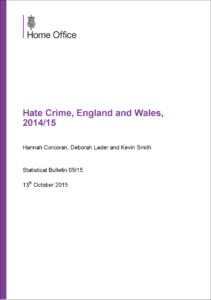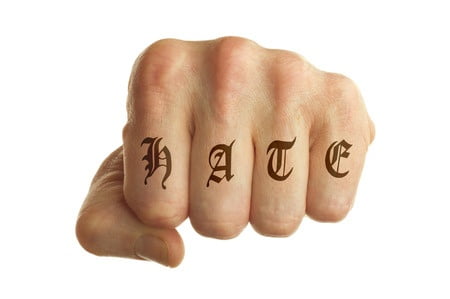Police recorded hate crime
Last week (13 October 2015) the Home Office published the hate crime figures for 2014/15.
In 2014/15, there were 52,528 hate crimes recorded by the police, an increase of 18 per cent compared with the 44,471 hate crimes recorded in 2013/14, of which:
- 42,930 (82%) were race hate crimes;
- 5,597 (11%) were sexual orientation hate crimes;
- 3,254 (6%) were religion hate crimes;
- 2,508 (5%) were disability hate crimes; and
- 605 (1%) were transgender hate crimes.
[It is possible for one hate crime offence to have more than one motivating factor which is why the above numbers add up to more than 52,528/100%.]
There were increases in offences recorded for all five of the monitored hate crime categories. However, the Office for National Statistics (ONS), has confirmed that action taken by police forces to improve their compliance with the National Crime Recording Standard (NCRS) has led to improved recording of crime over the last year, especially for violence against the person offences.
This better recording, together with a greater awareness of hate crime, and improved willingness of victims to come forward, are the main factors most likely to account for this rise in hate crime recorded by the police.
[divider]
Crime Survey hate crime figures
The true extent of hate crime becomes evident when we look at the figures  from the Crime Survey for England and Wales (CSEW).
from the Crime Survey for England and Wales (CSEW).
Based on combined data from the 2012/13 to 2014/15 CSEWs, there were an estimated 222,000 hate crimes on average per year for the five monitored strands. The most commonly reported motivating factor in these hate crime incidents was race, with an average of 106,000 incidents a year and the second most common motivating factor was disability (70,000 incidents per year).
Worryingly, even though CSEW respondents stated that 48% hate crimes came to the attention of the police, the overall CSEW hate crime figure is over four times that recorded by police.
Just as concerning is the fact that hate crime victims were less likely to be satisfied by the police handling of the incident, with 52 per cent being very or fairly satisfied compared with 73 per cent for crime overall.
[divider]
Conclusion
It remains extremely concerning that figures from CSEW suggest that less than one in 25 disability hate crimes were reported to and recorded by the police.









4 Responses
There are other important angles on this. While every effort is required to move our society to become more fair, tolerant and inclusive, I’m neither convinced that the criminal courts are the best way to change behaviour nor convinced that the figures represent more than changes in prosecution activities..
Most hate crime relates to low level criminality dealt with by fines and community orders (although sentencing is omitted from the detail of the report) and the “hate” element up-tariffs the disposal. This may be right and proper, however diversity promotion strategies are increasingly “moving away from beating people up with a diversity stick” and our understanding is that the behaviours tend to be related more to personal feelings of inadequacy and cognitive shortcuts. I believe that the hate element would be much better served in most cases by training workshops in the first instance. After conviction of a hate crime, an individual is particularly stigmatised and hate crime labels on criminal conviction disclosure certificates are particularly toxic and present considerable barriers for individuals to find employment or volunteering opportunities. Our experience with both employers and people with convictions find this to be true. There are other obvious toxic conviction labels relating to sex crime too which again tend to overshadow how serious, historical or relevant any particular offence is.
Thanks very much for the comment. I understand your rationale but 49% of the 222,000 hate crimes per year indicated by the Crime Survey were offences of violence which I never consider to be “low level criminality”.
I understand that stigma may make it difficult for perpetrators of hate crime to change, however victims of hate crime bear no responsibility whatsoever for being discriminated against or being subjected to physical attack. In my view, it’s important for society and the legal system to send out a very clear message about the unacceptability of hate crimes.
I was arrested (the charge was eventually dropped) for calling a Scotsman a Jock, I used the term in a non-confrontational manner, saying “can you loosen your grip on me Jock?” but unfortunately due to the creation of new laws, regarding former standard phrases of language I had 5 months of stress and fear that I was going to be convicted as using ‘Racist Language’ and as we all know it’s not what happened, but what is printed on a DBS that stays with you for life.
That certainly seems a bit extreme…